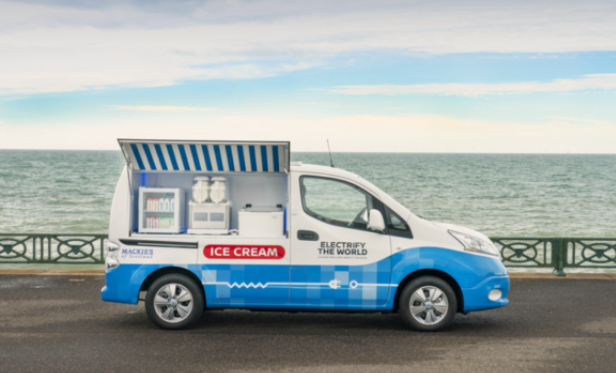Nissan has collaborated with Mackie’s of Scotland to create an all-electric ice cream van demonstration vehicle. By going with an electric motor and onboard battery systems, the typical ice cream van’s internal combustion engine was eliminated in order to create a zero-emissions vehicle.

As you probably know, Nissan long ago developed the electric NV200 based on its compact gasoline cargo van (the NV200). The e-NV200 was simply adapted for the ice cream concept with some technology innovations, such as adding Nissan Energy ROAM and several solar panels.
Alexandra Wenyon from Nissan Motors UK answered some questions for CleanTechnica about the demonstration van.
1. How did the all-electric ice cream van idea come about?
The issue of idling ice cream vans is gaining increased attention in the UK as people become more aware of the importance of reducing emissions and their impact on air quality.
Most ice cream vans have diesel engines which are kept running to operate the refrigeration equipment. These idling motors produce harmful emissions, including black carbon. By eliminating harmful tailpipe emissions, and increasing our use of renewable energy, Nissan has created a ‘clean’ ice cream van that also demonstrates Nissan’s Electric Ecosystem. This means that people can continue to enjoy their ice cream with the comfort of knowing the vehicle serving them generates zero emissions.
This project is driven by Nissan’s Intelligent Mobility strategy, which focuses on changing the way cars are driven, powered and integrated into society. The e-NV200 van already helps many business customers enhance their environmental credentials, representing a key pillar in Nissan’s wider commitment to cutting emissions. This project is the latest demonstration of the versatility of the technology available from Nissan.
2. What is the electricity source for the on-board soft serve machine, drinks fridge, and freeze drawer?
The on-board ice cream equipment, including a soft-serve machine, freezer drawer and drinks fridge, are powered by the newly unveiled Nissan Energy ROAM. The van also captures energy from the solar panels on its roof.
3. Can you explain what Nissan Energy Roam is and how it started?
The two Nissan Energy ROAM units have a combined storage capacity of 1.4kWh and can each output power at up to 1kW. They can be recharged either from a 230v mains supply (a full recharge takes about an hour), or the solar panel array on the van’s roof (a full recharge in 2-4 hours**). Nissan Energy ROAM is a battery pack with a 0.7kWh pack capacity and power output of 1kW. The ROAM is made out of old Nissan LEAF batteries.
4. How large is the battery pack just for the EV, and is there an estimated range for the van?
The e-NV200 is equipped with a 40kWh battery and has a 124 mile range (WLTP).
5. Will the concept vehicle make it to production, and, if so, when?
This is a working demonstration of the types of technology that could be implemented to solve the current challenge for traditional ice cream vans in reducing their emissions whilst ensuring one of the nation’s iconic traditions remains a part of British summer time.
Many of the individual components of the demonstration Nissan-Mackie’s Ice Cream van, such as the e-NV200 and Nissan Energy Solar – which features the same combination of solar panels and second-life battery technology – are available to UK customers. The recently launched Nissan Energy ROAM will also go into production in 2019.
6. What is the capacity of the solar panels on the van’s roof?
3 x 100 watt panels.
7. Could this concept be used for other food and beverage trucks?
It would depend on the power requirements, but if the appliances were within the ROAM’s operating capacity then a converter could create an alternative application.
